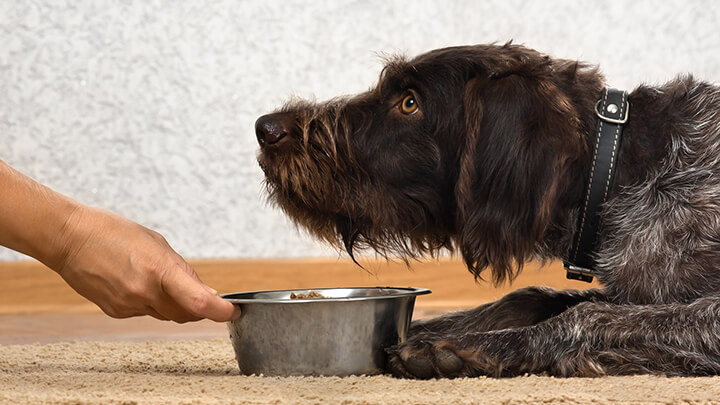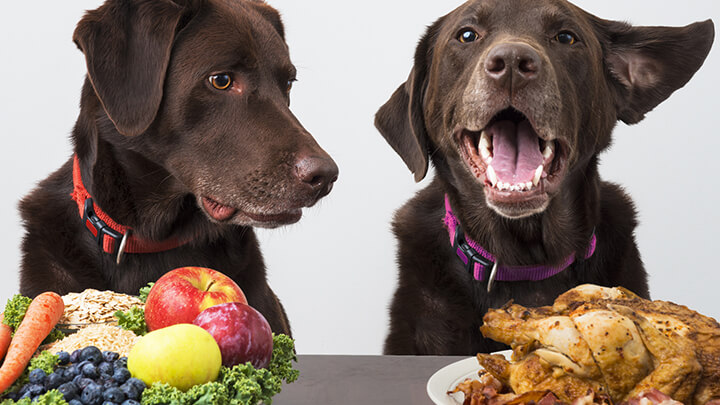
The Western world has made huge progress in the realm of healthy eating in the past two decades. We now fully recognize that what we put in our bodies quickly and fundamentally influences our physical, mental and even spiritual health. The rapid proliferation of health-conscious organizations like Whole Foods and even the ever-expanding organic produce and health food sections in our supermarkets has made becoming a healthy human easy.
So if we take our own health so seriously, why are we okay with feeding poison to our pets?
Personally, I’ve long shied away from conventional dog food with long ingredient lists. As the spokesperson for my own furry friend, I very much recognize the fact that her health is very much in my hands. And when I don’t recognize an ingredient that’s in a can of dog food or a bag of kibble, I put it back and move on. This has narrowed my options considerably, to the point where I only have a few go-to brands and generally just resort to feeding her fresh meat from the butcher supplemented with the occasional fruit and vegetable (yup, dog’s ancestral diets included things other than just straight meat).
Many people, however, don’t have the time or patience to sort fact from fiction while they’re browsing the dog food section of their supermarket or vet. They’ll see a brand like Purina, look at the happy dog with a shiny coat on the front of the pack, catch a glimpse of the odd phrase like “with real meat” or “all the vitamins and minerals they need,” and the deal is done.
But would they, or you for that matter, continue to buy conventional dog food if you really knew what they were putting in it? I’d be willing to guess that you probably wouldn’t.
What’s really in that dog food

It just so happens that the US Food and Drug Administration (FDA), the governing body that you trust to regulate what goes into your drugs, supplements and even food products, is also responsible for what goes into your prized pooch’s food as well.
And according to FDA policy, they don’t care what goes into dog food. According to the FDA, “No regulatory action will be considered for animal feed ingredients resulting from the ordinary rendering process of industry, including those using animals which have died otherwise than by slaughter, provided they are not otherwise in violation of the law.”
So what does that include? Well, “packinghouse offal, meat processing waste, restaurant waste and animal tissues,” for starters.
In essence, the FDA has made it legal to include almost anything in your dog food, as long as it resembled an animal at some point in the past. This means that anything derived from an animal that is dead, diseased, dying or disabled is fair game for your dog food.
These “4-Ds” permit dog food manufacturers to throw almost anything they can get their hands on into their products, as long as it was alive at some point in the last century or so. According to an article published in Baltimore’s City Paper, this could include rendered roadkill, decaying meat wastes from whatever the butcher wasn’t allowed to include in human food products, and the remains of thousands of euthanized cats, dogs and wildlife from the city shelter.
As long as the “meat” going into the dog food doesn’t contain any known “harmful microorganisms, toxins or chemical substances,” it’s perfectly fine with the FDA. And do you think they’re testing every chunk of roadkill or recently-euthanized animal for toxins or mold exposure? Chances are, they’re not.
A typical day at the dog food rendering plant
Baltimore company Valley Proteins is a major supplier of rendered fats and proteins to dog food giants Purina, Alpo, Heinz and more. Over the past few years, they’ve rendered grilling grease from almost every city and hotel in the city, a baby circus elephant that died in the summer of 2012, carcasses from the Baltimore Zoo, thousands of dead dogs, cats, foxes, deer, possums, raccoons and anything unfortunate enough to get peeled off the road. Valley Proteins also receives most of the waste meats and inedible animal parts that the region’s supermarkets won’t or aren’t legally allowed to include in their human food products. Delicious.
And, to me at least, what goes into those great bubbling vats isn’t half as bad as what’s coming out of them! Sure, old roadkill, slaughterhouse offal or even the occasional dead circus elephant is downright shocking and just a little bit gross, but dogs are scavengers by nature. Ever wonder where your pesky pooch runs off to at night, only to return home a couple of hours later with a full belly and a guilty look on his face? Dog’s digestive systems are designed for scavenging almost anything edible.
What they’re not designed for, however, is ingredients that have been cooked at ridiculously high heats in old, rancid grease until they no longer resemble their original form. For Valley Proteins’ Pet Food operation, that means throwing the various 4-D carcasses and other waste products into great vats of other waste oil, cooking it at high heat until the fats separate from the proteins, then making sure it’s centrifuged, pressed, magnetized, ground-up, sifted, cooled and stored for later use.
While this process helps to ensure safe, standardized dog food ingredients, it also means that they’re highly harmful to our dog’s health. The rancid oils in those vats are high in inflammatory omega-6 fatty acids and oxidized molecules that incite free-radical activity in the digestive system of the dog upon ingestion. The fats and proteins have been so denatured by the rendering process that the gastrointestinal tract of our furry friends have no idea what to do with it.
The implications are clear to see — just take a walk to the park. Overweight or obese retrievers, labs who can hardly walk due to their inflamed, arthritic joints, terriers with their hair falling out, collies who are virtually blind despite only just hitting five… it’s fair to say that a lot of the health issues emerging in our pets can be traced back to the food products we’re feeding them every day.
If that doesn’t make you think twice next time you reach for the Purina in the supermarket, consider this — there’s probably at least a little bit of cooked, sifted, mushed-up dog meat in that dog food you’re thinking about buying. Do you really want your pooch to be eating his own kind?
What to feed your dogs instead

Try this recipe for natural dog food. It is suitable for a small dog breed, around 20 pounds. Check with your vet on portion size and adjust the recipe according to the weight and fitness level of your pet.
Ingredients
- 1/3 cup fatty meat (beef or chicken offcuts, provided they don’t contain any sharp bones)
- 1-2 tbsp organ meat (beef, lamb or chicken liver)
- 2 tbsp cup cooked brown rice
- 2 tbsp shredded carrot
- 2 tbsp cooked peas
- 1 tbsp blueberries
- 1 tsp flax seeds
- 2 mint leaves, finely chopped
Instructions
- Simply combine all ingredients. Done!
— Liivi Hess

